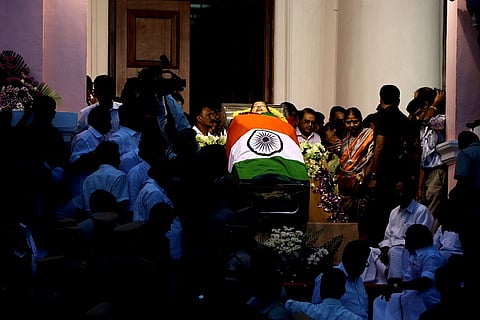

In a TN government-sanctioned press conference surrounding the former Chief Minister Jayalalithaa’s death, the doctors who treated her clarified that there were no CCTV cameras in her hospital room. They also said that no photographs were taken of her during hospitalisation.
"Firstly, you don't have CCTV in patient rooms. Secondly, you do not take photos of critically ill patients. How would they feel? I don't know how people can demand that. It is just extraordinary, it is unreasonable,” said Dr Richard Beale, a specialist from London who was involved with Jayalalithaa’s treatment.
The media briefing took place on Monday and was presided over by Dr Richard Beale, Dr Babu K Abraham, two of the specialists who treated Jayalalithaa and Dr Sudha Seshayyan, whose team embalmed Jayalalithaa’s body. Dr P Balaji, the TN government coordinator, was also present on the panel.
One of the questions posed repeatedly to them was why no photos of the leader were released during the 75 days she was at Chennai’s Apollo Hospital.
“It is not normal practice to take photos and publish private details. It is an intrusion into her privacy,” said Dr Beale.
The doctors asked journalists how they would feel if they were critically ill and their pictures had been taken.
Throughout Jayalalithaa’s hospitalisation, details about her health remained shrouded in mystery. With every press release Apollo came out with, the impression created was that Jayalalithaa’s condition was improving.
The cardiac arrest and her subsequent death therefore, came as a shock to her supporters, spurring many conspiracy theories that Jayalalithaa was poisoned and not given proper treatment.
This press conference was seen as an attempt to dispel the rumours around Jayalalithaa’s death as her political aide and confidante VK Sasikala is set to take over as Tamil Nadu Chief Minister.
Jayalalithaa was admitted to Apollo on September 22 when she complained of fever and dehydration. Doctors revealed to the media today that she was suffering from breathlessness when she was brought to the hospital.
The doctors also shed light on the sequence of events which ultimately led to her death.
After being admitted, the first tests were conducted and it was found that Jayalalithaa was suffering from a bacterial infection.
Dr Richard Beale revealed that sepsis set in quickly, spurred on by Jayalalithaa’s diabetes. Sepsis is a condition caused by infection in the blood. A massive immune system response is triggered by the body which can cause inflammation to one’s own tissues and organs and also lead to organ failure.
At the time when sepsis was detected, Jayalalithaa was still conscious and responding. “For a period of time, she was treated with non-invasive ventilation. While her initial condition improved somewhat, the sepsis progressed. It was necessary for her to go ventilator,” Dr Beale said.
Within ten days of hospitalisation, Jayalalithaa was put on respiratory support and antibiotics. Dr Beale said that the respiratory failure was a result of sepsis.
It appears however that Jayalalithaa was conscious again but on heavy sleep medication. Reporters questioned the doctors then about how aware Jayalalithaa was when she signed the Election Commission papers for AIADMK candidates for bye-elections in three constituencies.
Doctors said that Jayalalithaa continued to be interactive, communicating with signs, while the doctors lip-read to understand her. However, she was only able to give thumb impression on the papers, they claimed. She had just undergone tracheostomy at the time and her right hand was inflamed.
Nearly two months after her hospitalisation, Dr Pratap Reddy, Apollo Chairman, had said that Jayalalithaa was using the tracheostomy tube for 15 minutes everyday but otherwise was free to go. A few days after that, another statement by Apollo said that Jayalalithaa was breathing on her own 90% of the time and was speaking briefly with the help of speaking valves. She was also undergoing physiotherapy.
When asked about how Jayalalithaa could be receiving physiotherapy when she was bedridden and heavily sedated, the doctors responded that physiotherapists and dieticians were part of a team working together to devise the best way to improve Jayalalithaa’s condition.
As the details of her treatment came out, reporters continued to question the doctors about why Jayalalithaa’s photos were not released to the public. The one question on everyone’s mind was - when a public personality was involved and while so many of her supporters waited outside the hospital, why didn’t they release any visual proof of what they were claiming?
Questions were also raised about the authenticity of the doctors’ claims without any visual proof.
The doctors however, stuck to their guns, and said they wouldn’t infringe on anyone’s privacy. One of the doctors asked: “If you fall sick and come to the ICU, would you like your details to be told to everyone?”
Jayalalithaa suffered a cardiac arrest on December 4. Dr Beale said that it was a witnessed cardiac arrest and resuscitation was done immediately. “The CPR went on for 20 minutes, but there was still no heartbeat. She was then put on ECMO,” said Dr Balaji.
ECMO or extracorporeal membrane oxygenation is a process through which functions of the heart and lungs are carried out outside the body using a special machine.
Dr Balaji explained that in case of ECMO, at least 24 hours need to be given to see if the heart responds or not. Dr Beale said that the news of the cardiac arrest surprised him. “I was participating remotely. I couldn't join in because of realities of travelling. It was out of blue, the collapse, especially when she was on road to recovery,” he said.
There was still no heartbeat after 24 hours. “There was a discussion with a team of experts and also with doctors from AIIMS. It was realised then that it was futile to continue therapy,” said Dr Balaji.
Jayalalithaa’s death was announced on December 5, at around 11.30pm.